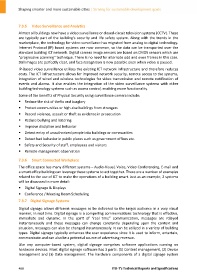Page 498 - Shaping smarter and more sustainable cities - Striving for sustainable development goals
P. 498
7.3.5 Video Surveillance and Analytics
Almost all buildings now have a video surveillance or closed‐circuit television systems (CCTV). These
are typically part of the building’s security and life safety system. Along with the trends in the
marketplace, the technology for video surveillance has migrated from analog to digital technology.
Internet Protocol (IP) based systems are now common, so the data can be transported over the
standard building ICT network. Digital camera image sensors are based on CMOS sensors which use
"progressive scanning" technique. There is no need for alternate odd and even frames in this case.
Still images are perfectly clear, and face recognition is now possible even when video is paused.
IP‐Based video surveillance utilizes the existing ICT network infrastructure and therefore reduces
costs. The ICT infrastructure allows for improved network security, remote access to the systems,
integration of wired and wireless technologies for video transmission and remote notification of
events and alarms. It also enables the integration of the video surveillance systems with other
building technology systems such as access control, enabling more functionality.
Some of the benefits of Physical Security using surveillance camera include:
Reduce the risk of thefts and burglary
Protect communities or high‐rise buildings from strangers
Record violence, assault or theft as evidence in prosecution
Reduce bullying and loitering
Improve discipline and behavior
Detect entry of unauthorized people into buildings or communities
Detect bad behavior in public places such as government offices etc.
Safety and Security of staff, employees and visitors
Remote management observation
7.3.6 Smart Connected Workplace
The office space has many different systems – Audio‐Visual, Voice, Video Conferencing, E‐mail and
a smart office building can leverage these systems to act together. There are a number of examples
related to the use of ICT to make the operations of a building smart. Just as an example, 2 systems
will be discussed in more detail:
Digital Signage & Displays
Conference / Meeting Room Scheduling
7.3.7 Digital Signage Systems
Digital signage allows different messages to be delivered to the target audience in a very visual
manner, in real time. Digital signage is a compelling communications technology that is effective,
immediate and dynamic. In the spirit of “real time” communication, messages are relayed
instantaneously and these messages can change constantly depending upon the context and
situation, messages can also be changed instantaneously. It can be utilized in a variety of building
types. Digital signage typically enhances the user experience since it is used to inform, entertain,
communicate and can also be a potential source of advertising revenue.
Like any computer‐based system, digital signage comprises software applications running on
hardware devices. Most digital signage software has 3 parts: (1) Content management, (2) Device
management and (3) Data management. The hardware components of a digital signage system
488 ITU‐T's Technical Reports and Specifications

